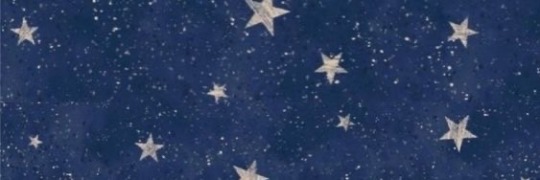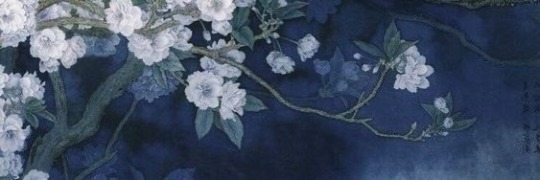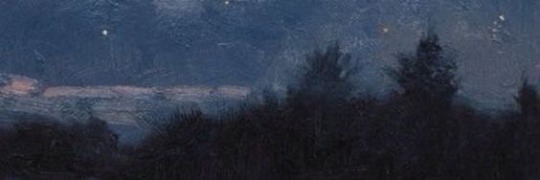Text
me when ppl talk about God/Jesus: that's so cool i'm glad you feel fulfilled in your religion!! that's such a good feeling to have :))))
christian ppl when i talk about my polytheism: the DEVIL?????? EVIL?????? EVIL BAD ??????????? EVIL BAD DEVIL BAD EVIL????????????? praying that you FREE yourself from the SHACKLES of EVIL. be like me NEOW
me: um no i find a lot of peace and security and happiness in my religion actually
christians: okay well STOP
31 notes
·
View notes
Text
All of these things are true
Magic is not nearly as complicated as most people think.
But.
If you don't know the rules, you can't understand how to break them.
And.
There are no rules.
84 notes
·
View notes
Text
Crafts of the Witch Useful to Learn
Welcome to December 25th, here's some stuff about witchcraft to think about because you're on your phone looking for a distraction :)
So anyway here's stuff that's really useful to learn how to do before you actually need it because putting it all together for the first time on game day is stressful.
Creation and Desecration of a Poppet
A poppet is a deeply sympathetic representation of someone or something (usually another person).
According to the law of sympathy, whatever you do to the poppet will happen to the person it represents. You could cleanse and bless it, or smite it.
Poppets can be made in a wide variety of ways, from paper dolls, to clay figurines, to crocheted stuffies - anything you like. They also must be worked over magically to link them to their target.
The most ideal poppet is decorated to look very similar to the thing it represents, and is imbued with a taglock (such as hair, nail clippings, footprint dust, etc).
Learning Prompts:
The handicraft of creating the poppet - start with any arts and crafts you're interested in and see if they'll work for you
Practice making several poppets - you do not need to consecrate them. How easy is it for you to decorate it just like the real person? How easy is it for you to include taglocks?
Find a disposal plan. ""Voodoo dolls"" are steeped in public awareness; will it be safe for you to throw away the poppet in the trash when you're done with it?
Consecration or enlivening poppet as target. Find or develop a ritual to fill the poppet with magical life so that it becomes the target. Practice this once or twice (perhaps on a poppet of yourself, to cast blessings or prosperity magic on yourself)
Desecration or severing link. Find or develop a ritual to end the sympathetic link between the poppet and its target. Practice this once or twice.
Storage and tending of enlivened poppets. They are alive and they act like it. If you intend to have poppets sitting around for long-term spells or to use as-needed, you will need a system of storing them so that they "go to sleep" and remain undisturbed until you need them.
Consecration, In General
Here I mean "consecration" to be an act of magic which anoints an object as sacred unto a purpose, and therefore primed for magical use. In crude terms: you're making an object magical and giving it a purpose at the same time.
Consecration is a very useful thing to know how to do. In and of itself it can form a kind of minor enchantment (I consecrate this mug of oolong tea to be a potion of survival +1), but it can also prepare the way for powerful enchantments (I consecrate this ring to become a divine protector, ready to receive the powerful enchantment I soon cast upon it).
Learning Prompts:
Find or create a minor consecration spell which can be cast in under a minute. Strive to obtain one which is covert and can be done even in the presence of others. (Perhaps we could call this a 'cantrip'). Such a spell tends to be suitable for moving fate a few degrees over, or to dig a shallow pool in the tides of reality.
Find or create a hefty consecration spell. Consider what abilities or access you have that allows you to redefine the fate and purpose of an object. Contemplation of this spell can provide great insight into one's own belief and path. Such a spell may completely reorient fate, and carve new channels into the waterways of reality.
Practice minor consecrations on 5 different types of objects. Consecrating the tea, that's easy - stir it a few times. But how to consecrate a hairbrush? How to consecrate a mirror?
Practice major consecration twice, unto two very different domains. Perhaps a pepper oil of fiery smiting, and a crystal bracelet of deep soothing. This is an opportunity to compare and contrast the powers you raise when you work within different domains.
Desecration, In General; and Spell Reversal
To make profane; as in, to remove the magic from something and make it no more than a lump of physical matter, or a meaningless event like scattered dust on the winds of fate.
In my opinion, all witches should learn this - "don't raise up what you can't put down" also includes "don't enchant shit if you don't know how to undo enchantments."
To know how to nullify magic also means you can nullify unwanted and harmful things around you, and take the force and energy out of them.
Learning Prompts:
Find or create a minor desecration spell, one that you can cast on the fly and without tools or ingredients. Such a spell may be like a slapping a broom on a dusty rug; it will shake free things not tightly held.
Find or create a major desecration spell. Such a spell is like steam cleaning and shampooing a rug; it must remove every particle of magic and leave nothing behind but stripped fibers.
Practice minor desecrations 5 times in day-to-day life, targeting stank vibes and irritating situations that do not serve you.
Practice minor consecrations and desecrations 5 times by consecrating a stone, candle, etc., unto a magical purpose, and then removing the consecration.
Find an opportunity to cast a major desecration, which you may find the opportunity to do the next time the need for banishment comes up; or when sorting through old magical tools you no longer need, etc.
Find or create a solid spell reversal, one that you can use without having to have physical spell remnants on hand. Note that reverse to sender is not the same as nullifying your own magic.
Binding Divination Tools to Veracity, and Sundry Divination Management
Or if you like, binding veracity to divination tools. Binding is not baneful magic. Binding means to attach one thing to another thing, or to prevent something from being ways.
You can cast a binding on your divination tools to constrain them to only tell the truth, to truly peer beyond the veil, and only deliver what it can see; and never reflect your personal whims.
There's plenty of magic you can cast for your divinatory tools to make your life easier.
Prepare a binding spell to constrain a divination tool to only reflect the kind of truth you want. Do you want a tarot deck to only show your true state of mind? Do you want a set of runes to only read the will of the gods? Do you want your charm set to only read on the future, and not the past?
Find or create a protection spell to stop undue influence on a divination tool. This does not mean "evil spirits are manipulating your reading." Undue influence also means the strong emotions of querents, random psychic garbage, and the like; but it can also have an impact on the way you phrase questions and work with the tool itself.
Find or create a spell to enchant your tool as a magical seer/oracle. You can use a tarot deck out of the box, of course. You can also enchant it to be a magical object that obtains truth from mystical sources. Try it and see if you like the difference.
Find or create a charging ritual to revitalize your divination tools. This is a good opportunity to examine elemental energies; what kinds of energies are best suited to the purposes of divination and seeing beyond? The full moon is classically used for such purposes. Challenge yourself to recharge your divination tools once a month for 3 months, and see if you like the difference.
Blessing, In General
You have the power to generate and coalesce benevolent and helpful energies, and to distribute them into the world around you. You can bless anything you like, and perhaps the more the merrier; it's a very fine way to transform a space, and put love into the world.
Try considering blessings to have 2 parts; the first is to evoke a desirable force, and the second is to apply the force in a certain way: You could evoke the winter dawn as a blessing power, and then ask it to do something specific (provide a calm day, to make wise choices, to avoid bad traffic, etc).
Write your own minor blessing spell that you can perform in a minute or less. Try centering this blessing around a wonderful and benevolent force, whether it be a certain god, mushrooms, unconditional love, and so forth.
Write a separate minor blessing spell using a very different focus. Try the deep blue calming waters of the deep ocean, or the sprightly breezes of alpine hills, or the feeling of the first sip of a perfect bowl of soup; but make it have really different vibes from the first blessing.
Practice both minor blessings and see the difference. Challenge yourself to use each blessing cantrip 5 times. Try clustering the blessings to fill a space with that kind of energy (such as five items on desk blessed under the alpine breeze, and five items in the bathroom blessed under the deep ocean). Can you feel a difference in the spaces as you move in and out of them?
Write a major blessing using the various benevolent and lovely powers of your practice. This is another good opportunity to explore your practice. When you are in need of love, kindness, grace, and softness, what part of your path rises to meet your needs?
The Big Practice
Consecrate a poppet unto yourself. Bind and enchant a divination tool to be a powerful oracle of truth, and read on the most helpful equipment the poppet needs (RPG style: weapon, armor, familiar, potion?).
Whatever the answer, make a tiny container spell which serves the purpose. Consecrate it to be the tool that the poppet (you) needs.
Give the enchanted container spell to the poppet and cast a blessing on it, to be empowered with the new tool it has been granted in life.
Carefully store the poppet and its tool.
Periodically, perhaps between 1 to 6 times a year, recharge your divination tool and discern what new tools the poppet might need. Desecrate the old tool if you need to (or let them stack up), and consecrate new tools.
Keep the poppet and its tools for as long as you like, carefully severing the link between yourself and it when you're done with it.
818 notes
·
View notes
Text
🌹💞Rose Water
Another post of magical waters. This one is similar to that of Angel's Water, but might be more accessible to people.

What is Rose Water?
Rose Water is a magical water made from infused rose petals. Because of the associations with roses being romance, beauty, love, sexuality, sensuality, etc. Rose Water is used in glamour and love magic spells as a way to attract, enchant, and strengthen love and beauty.
Rose Water is popular in the health and beauty aspect, being used as a skin care product like a cleanser. And of course a s a perfume.
How do I make Rose Water?
There's three methods to making Rose Water, figure out which one might be best for you! Make sure your roses are organic and haven't used pesticide.
Method 1: Place a heat proof bowl in a pot, place your rose petals around that bowl into the pot, and pour water into the pot, avoid pouring into your bowl. Bring it to a boil and then down to a simmer. Place your pot's lid on upside down and place ice cubes on top. This makes it so the evaporated water goes up and meets the cold environment, and turns back into liquid (distilled water) and drips right down into your bowl, creating Rose Water.
Place more ice cubes when they melt, you can dap the melted ice cubes away with a rag. When the colour of the roses are gone, you're done! Strain into a bottle. Should last about a month.
Method 2: Simply boil distilled water and roses together until the petals loose their colour, strain into a bottle for use. More roses mean stronger smell and more water means lesser smell. Should last for about half a year.
Method 3: Rub your rose petals to bruise them a bit, and place them in a tight sealed glass container with cold water. Let it sit for 24 hours in your fridge. Strain in the morning. Should last a month.
Where do I use Rose water?
Rose water is typically used a s face toner, body spray, hair spray, or cleanser for the wearer. This is why it's important that the rose are organic. Rose Water can also be used for potions and consumptions in love magic.
It can also be used as a room spray or for your clothes, Rose Water is used heavily in glamour magic.

263 notes
·
View notes
Text
A Guide To Shape-Shifting
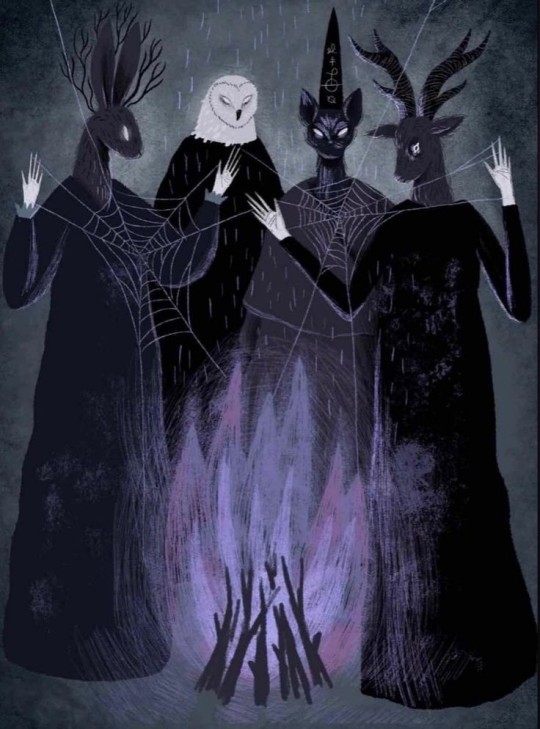
Shape-shifting has long captivated the human imagination, holding a prominent place in the realms of witchcraft and the occult. In fact, the myth of the shape-shifting witch can be found in folklore around the world and across multiple cultures, from the British Isles to the Americas to Asia and Africa. Witches were reported to turn into rabbits, cats, deer, mice, owls, ravens, and wolves. Shape-shifting is an intriguing practice that involves altering one's physical form, or at least one's perception and is often associated with mystical abilities and spiritual connections.
What Is Shape-Shifting?
Shape-shifting, in the context of witchcraft refers to the belief and practice of altering one's form or perception through magick and ritual and can take place in the Otherworld or on our current astral plane, depending on the needs of the witch. It encompasses the idea of undergoing a physical or metaphysical transformation, allowing witches to embody different beings, animals, or even objects. Often times this occurs when the witch wears the body of an animal, we know literal transformation is not possible, but it can certainly happen on an energetic or spirit level. This can occur in one of two ways: the witch's spirit transforms into the spirit of an animal or the witch's spirit 'rides' a living animal or external spirit on the physical plane or in the Otherworld. In either case, both are considered shape-shifting and can be used for the same purposes.
Some History
By the 13th century, it was widely believed witches could turn into animals at will. Witches were believed to turn into hares, toads, dogs, cats, and other animals to steal from their neighbors, curse livestock, and otherwise create mischief and mayhem. In many cases, harm done to the animal form caused similar wounds to the human.
In 1649, John Palmer of St. Albans, England confessed to transforming into a toad in order to torment his neighbor. The neighbor reportedly kicked the toad and Palmer complained of sore shins afterward. Similar stories appear in American folklore, including Aunty Greenleaf who was said to take on the form of a white doe to torment her neighbor's livestock. When the doe was shot with three silver bullets, Aunty Greenleaf was said to later die with three silver bullets in her spine.
Of course shape-shifting myths and folklore don't end there. We also have the Navajo skinwalker, the American loup-garou, Korean kumiho, Japanese yokai, the Kitsune, and the Mexican La Lechuza.
Famous incantations come from Isobel Gowdie during the 17th century witch trials. During her confessions, Gowdie named two charms one for transforming into a hare and and one for transforming back into a woman.

To Transform Into A Hare:
"I shall go into a hare
With sorrow and such a meickle care;
And I shall go in the Devil's name
Ay while I come home again."
To Transform Back:
"Hare, hare, God send thee care.
I am in a hare's likeness now,
But I shall be in a woman's likeness even now."
Other witches reported similar shape-shifting incantations as seen below.
To Transform Into A Cat:
"I shall go into a cat,
With sorrow and such a black shat;
And I shall go in the Devil's name,
Ay while I come home again."
To Transform Into A Crow:
"I shall go into a crow,
With sorrow and such a black thraw;
And I shall go in the Devil's name,
Ay while I come home again."
Modern Uses Of Shape-Shifting
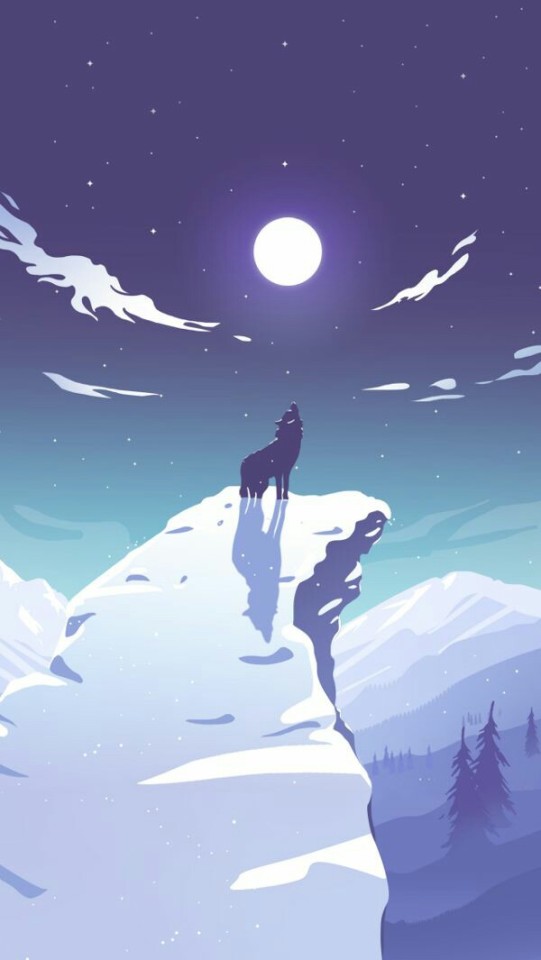
In contemporary witchcraft, shape-shifting has taken on metaphorical and symbolic significance. Modern witches utilize shape-shifting as a tool for personal growth, empowerment, and self-discovery. Through the exploration of different archetypes and primal instincts, witches seek to deepen their understanding of themselves and their connection to the natural world, develop a relationship with an animal guide or totem, or even gain new perspectives on a problem. Shape-shifting becomes a means to tap into hidden aspects of the psyche and to embrace transformative experiences. This can take many forms, including calling upon different animal spirits during spellwork, meditating on different animal aspects, working with animal spirits, journaling, ritual dances, etc.
Shape-shifting also shares a deep connection with shamanic journeying and hedge riding, a practice in which the witch traverses the different realms of the Otherworld for spiritual insight and healing. Within hedge riding and othet shamanic traditions, shape-shifting serves as a means to enter other dimensions, communicate with spirits, and tap into their wisdom and attributes. By assuming the form of a particular animal, the shamen can embody ita qualities, accessing unique perspectives and guidance on their journey. An animal form is also taken often as a form of protection during otherworldly travel, as animal spirits are often able to traverse undetected, acting as a form of invisibility, much like Celtic fith-fath incantations. An animal form also allows the witch to travel more quickly and in some cases, access areas previously unreachable, such as high mountain tops, deep within an ocean or lake, or even borrowing underground or into tight spaces.
How To Shape-Shift
Modern witches engage in shape-shifting through various techniques and practices. Visualization exercises play a significant role, where witches create vivid mental images of their desired form or archetype, often coupled with ritual work such as wearing animal skin/bones, dancing, drumming, or incantations. Through meditation, yoy can enter a state of deep focus and receptivity, allowing yourself to embody the essence and qualities of the chosen form. Energy work such as harnessing personal energy or working with elemental forces, can serve as a catalyst for the transformation, although most witches find it easier to use a mask or skin, or use an ointment to prompt the change. Needless to say, there are multiple approaches to shape-shifting and you need to experiment to find which method works best for you. Below are several ways to engage in shape-shifting from both folklore and modern witchcraft.
• Incantations And Charms- This is probably one of the most commonly cited historical ways to shape-shift, with the incantations from Isobel Gowdie and her fellow witches being cited most often. These incantations can be modernized and adapted to turn you into any animal you desire. Since most witches do not incorporate "God" or the Devil in their craft, these titles can be changed to reference deities or the forces you believe in such as Lord/Lady, Horned God, Hekate, Lilith, etc. Pagan musician Damh the Bard does an excellent job of this in his "Fith Fath Song" where he says "I shall go as a wren in spring
With sorrow and sighing on silent wing
And I shall go in our Lady's name
Aye, til I come home again
Then we shall follow as falcons grey
And hunt thee cruelly for our prey
And we shall go in our Horned God's name
Aye to fetch thee home again
Then I shall go as a mouse in May
Through fields by night and in cellars by day
And I shall go in our Lady's name
Aye til I come home again
Then we shall follow as black tom cats
And hunt through the fields and the vats
And we shall go in our Horned God's name
Aye to fetch thee home again... "
Of course writing your own incantations works just as well, if not better, than using others' words.
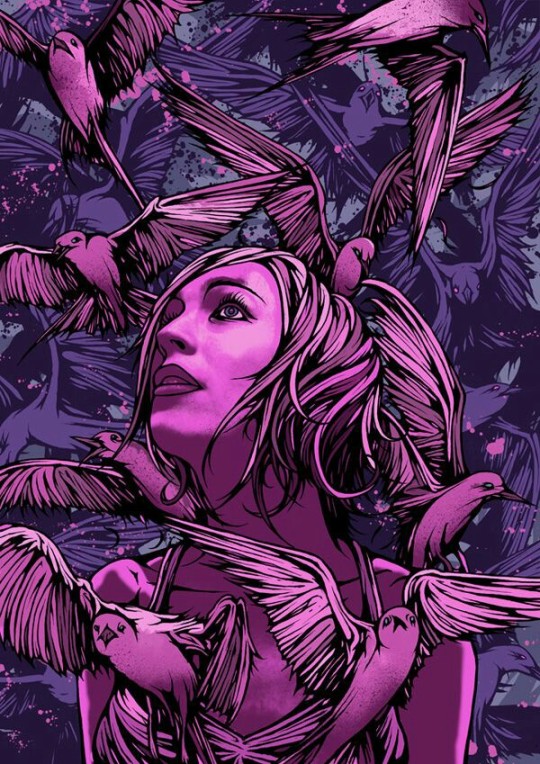
• Wearing Animal Skins, Bones, Or Masks- Apart from incantations, many witches engage in shape-shifting by animal skins, bones, or masks to encourage a transformation. This is often coupled with ritual dancing and drumming until an altered state of consciousness is reached. In Call of the Horned Piper, Nigel Jackson describes such a ritual. In order to shape-shift, the initiate would undergo a symbolic death by undressing and crossing a lake or other body of water. Upon arriving on the other side they would don a wolf skin or belt and enter into an altered state of consciousness to "be projected forth into the form of a wolf". This same practice can be replicated with any animal pelt, bone, or mask, using a cold shower as the bridge to 'death' should you not have access to a river or lake and privacy.
• Trance, Meditation, and Visualization- Reaching an altered state of consciousness coupled with one or both of the aforementioned methods is the key to actual transformation. Reaching an altered state of consciousness can be done in a variety of ways, including ritual dancing, drumming, humming, consuming psychoactive plants, or using ointments. The methods used are essentially the same as hedge-riding, however the goal of reaching the trance state is to shape-shift. With that intention firmly in your mind, you can visualize yourself shifting into your animal form, your consciousness slowly becoming that of an animal. You may find walking/crawling on all fours, growling, hissing, or otherwise behaving like the animal aids in this transformation. Become the animal you wish to transfrom into.
If you are looking to shape-shift while hedge-riding, visualizing the shift, reciting an incantation, and donning your animal garb within the Otherworld will also work. Unlike on our plane, you won't need to shift your consciousness again, as that has already occurred. While you don't necessarily need anything physical to do this, having real animal remains or a mask on your person prior to hedge-riding will greatly aid you in your work on the astral plane.
When first starting out, start small, shape-shifting for very short periods of time. Experiment with a variety of methods, combining them into a ritual that works for you.
Shape-Shifting Safety
There are dangers to shape-shifting into an animal form. This includes not being able to return to your body because tou have forgotten you're human, forgetting which realm you belong to, being captured, injured, or killed within the Otherworld or while riding a live animal. There are many tales of witches traversing the world as an animal and being injured only for the same wounds to appear on the witch's human form. These injuries sometimes resulted in the death of the witch, so be mindful of hazards while shape-shifting.
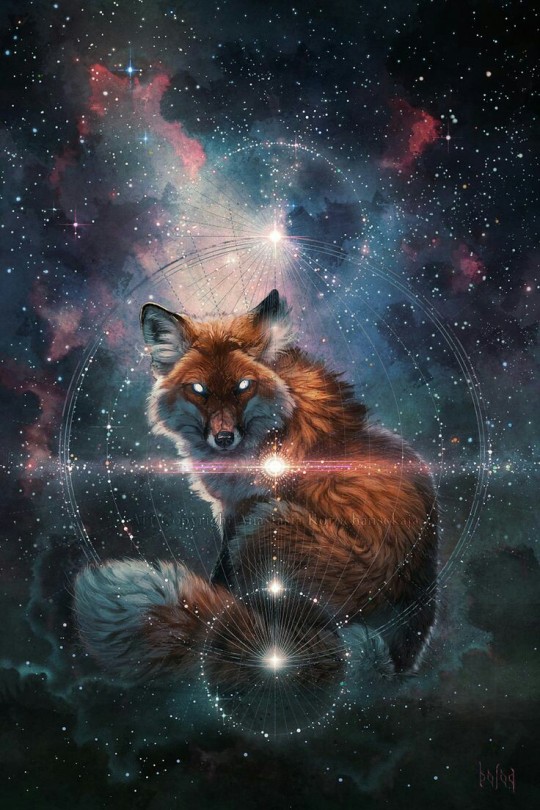
What You Can Do To Protect Yourself
1. Set clear and firm boundaries and time limits for travel. Setting an alarm or using a musical cue can help pull you back from a trance.
2. Have a spotter who can help rouse you should you not come back when originally planned.
3. Have a safe word or incantation that when spoken pulls your spirit into your body.
4. Use a red witch's thread tied around your finger or arm to anchor your spirit to your physical body. If you get lost, follow the thread back to your body.
5. Carry or wear protective charms that will prevent your spirit from being stolen or harmed while in the Otherworld. Your familiar or household pet can also act as a protector of your body, sitting on or near you during shape-shifting to ensure nothing else tries to inhabit your body.
6. When you are finished, make sure you are completely grounded in your human body.

Shape-shifting in witchcraft remains an enigmatic and alluring practice, intertwining myth, history, and contemporary spirituality. It offers a gateway to explore the depths of our own selves, connect with the primal forces of nature, and embark on transformative journeys of self-discovery. Whether through the exploration of archetypes, communion with spirits, or embracing the hidden aspects of our being, shape-shifting provides a mystical transformation that resonates with the essence of true witchcraft.
582 notes
·
View notes
Text
Pages about color correspondences from my Grimoire.










869 notes
·
View notes
Text

Full Moon in Taurus 15th November 2024
Full Moon in Taurus highlights themes of stability, security, and comfort. It’s a time to release what no longer serves you and focus on building a solid foundation.
Advice: Embrace your sensual side and focus on creating a sense of peace and stability in your life.
Activities: Engage in self-care, enjoy a sensory experience, or focus on financial security.
For Full Moon in Taurus, Tree Pose (Vrksasana) encourages grounding and balance. Stand tall with one foot rooted into the ground, arms raised, embodying Taurus’s stability.
30 notes
·
View notes
Text
With everything going on right now, I'm just going to say this again:
Witch is gender neutral.
Men, women, binary people, all can be witches. Trans people, gay people, bisexual people, asexual people, all queer people, can be witches.
Witch is a self claimed title. A witch chooses to become a witch and call themselves a witch. Or not. "Natural born witch", "hereditary witch", "destined witch", aren't actually a thing like a lot of people tend to think they are.
Those who do not call themselves witches, do not call them witches.
162 notes
·
View notes
Text
Spell Casting - Time of Day
Dawn - renewal, rebirth, new beginnings, new ideas, creativity, cleansing, healing
Morning - achieving goals, brewing potions, intellect, intelligence, love, relationships, companionship
Noon - solar magic, confidence, success, attainment, wealth, courage, strength, protection
Dusk - release, letting go, peace, reflection, breaking bad habits, transformation, banishing
Evening - cursing, banishing, binding, dream magic, celestial or planetary magic
Midnight - lunar magic, psychic awareness, intuition, spirituality, divination, peace, relaxation
Twilight - liminal space; transitions, change, transformation, astral travel, traveling to other realms, spirit communication
updated 10.5.24
© 2024 𝚊𝚍-𝚌𝚊𝚎𝚕𝚎𝚜𝚝𝚒𝚊
1K notes
·
View notes
Text

“You will never be happy if you continue to search for what happiness consists of. You will never live if you are looking for the meaning of life.”
-Albert Camus ☕️🌙
9K notes
·
View notes
Text

A picture from when I was on the way to Delphi
I felt Apollo's presence so strongly all the way to and at Delphi. We went to his temple and I got some photos. I hope I can go back here again. <3









624 notes
·
View notes
Text
A guide to worship of Dionysus - cheat sheets


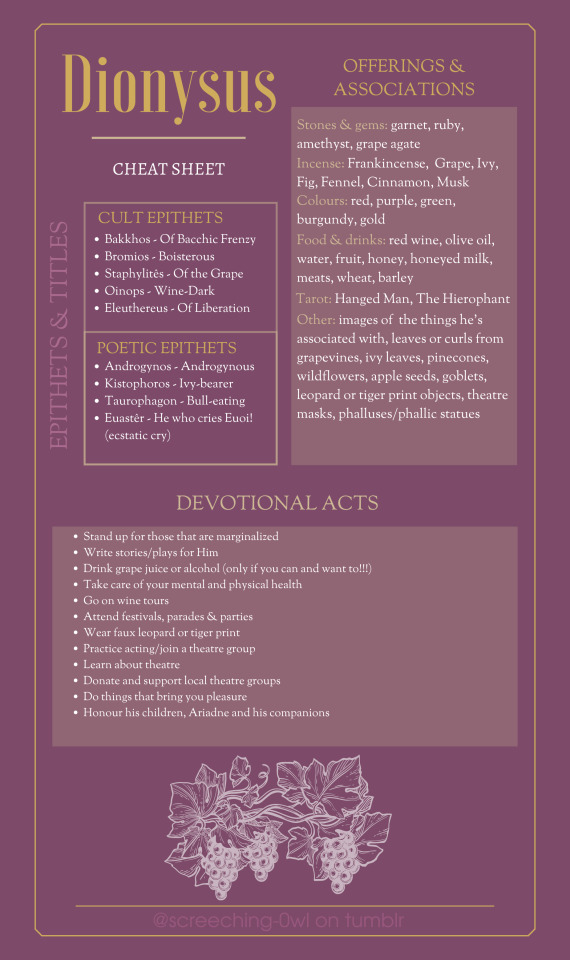
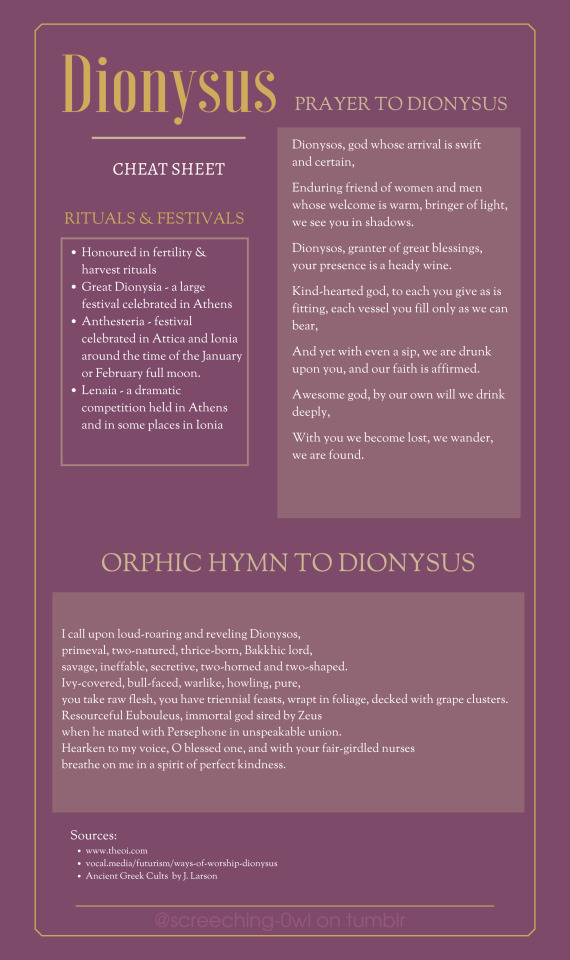
Hellenic cheat sheets
If you like my content consider supporting me on: https://ko-fi.com/screeching0wlet
3K notes
·
View notes















